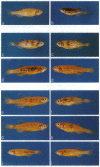Abstract
To determine whether embryonic cells transplanted from one zebrafish embryo to another can contribute to the germ line of the recipient, and to determine whether pigmentation can be used as a dominant visible marker to monitor cell transplants, we introduced cells from genetically pigmented (donor) embryos to albino recipients at midblastula stage. By 48 hr many of the resulting chimeras expressed dark pigment in their eyes and bodies, characteristics of donor but not albino embryos. By 4-6 weeks of age pigmentation was observed on the body of 23 of 70 chimeras. In contrast to fully pigmented wild-type fish, pigmentation in chimeras appeared within transverse bands running from dorsal to ventral. Pigmentation patterns differed from one fish to another and in almost every case were different on each side of a single fish. At 2-3 months of age chimeras were mated to albino fish to determine whether pigmented donor cells had contributed to the germ line. Of 28 chimeric fish that have yielded at least 50 offspring each, 5 have given rise to pigmented progeny at frequencies of 1-40%. The donor cells for some chimeras were derived from embryos that, in addition to being pigmented, were transgenic for a lacZ plasmid. Pigmented offspring of some germ-line chimeras inherited the transgene, confirming that they descended from transplanted donor cells. Our ability to make germ-line chimeras suggests that it is possible to introduce genetically engineered cells into zebrafish embryos and to identify the offspring of these cells by pigmentation at 2 days of age.
Full text
PDF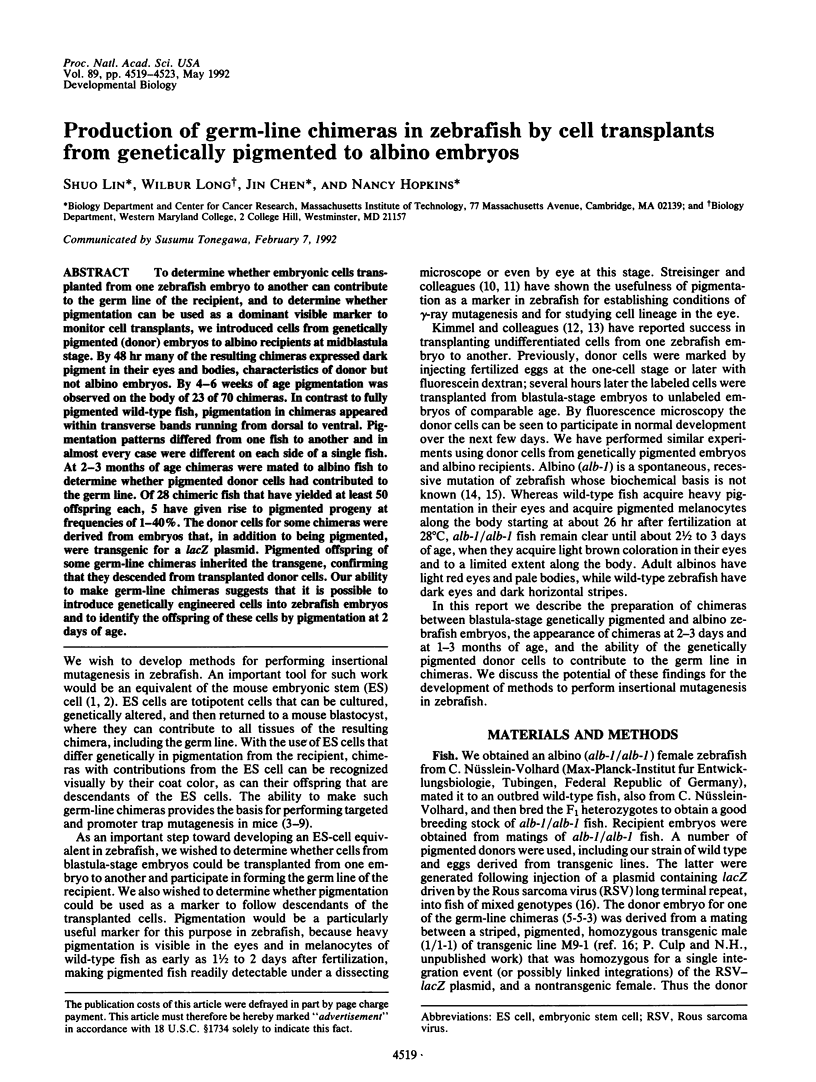
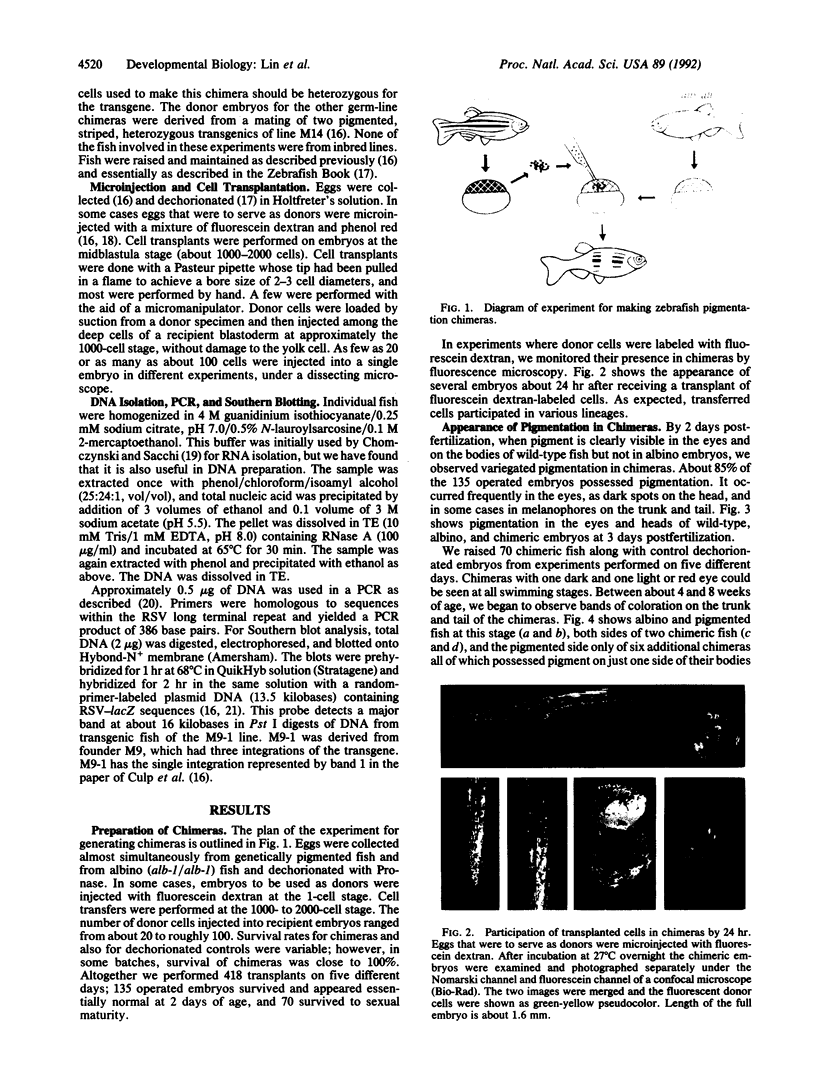
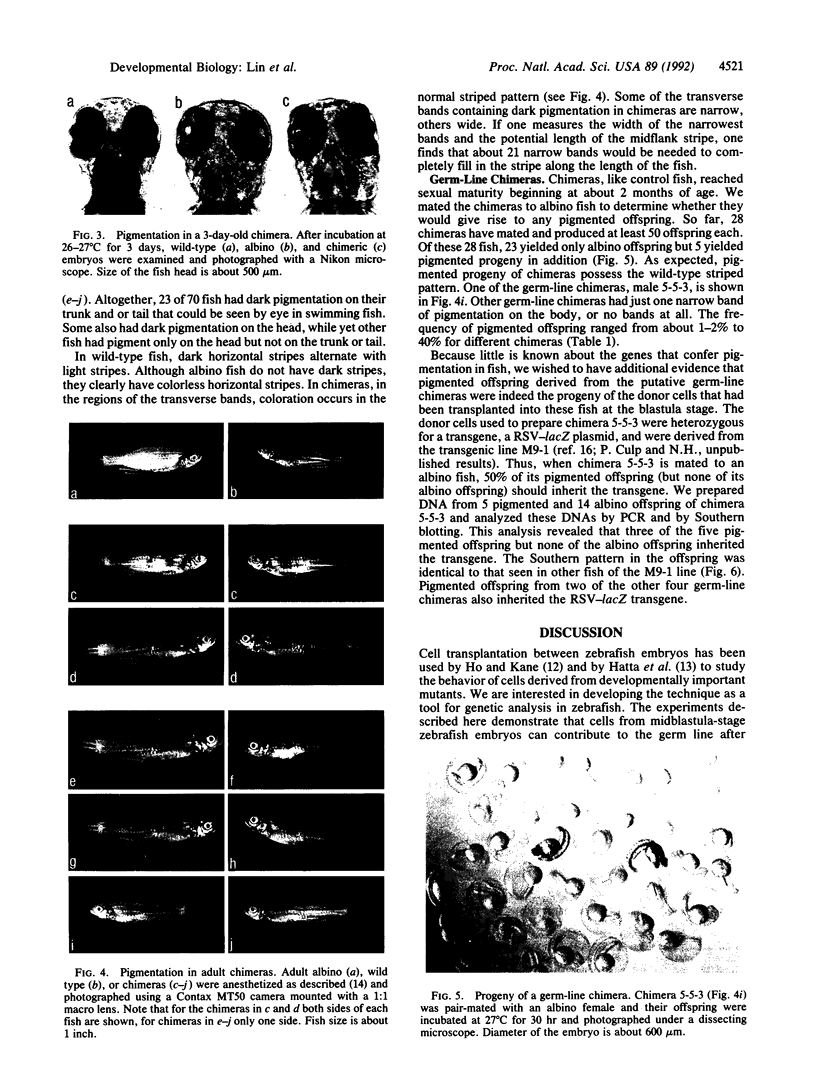
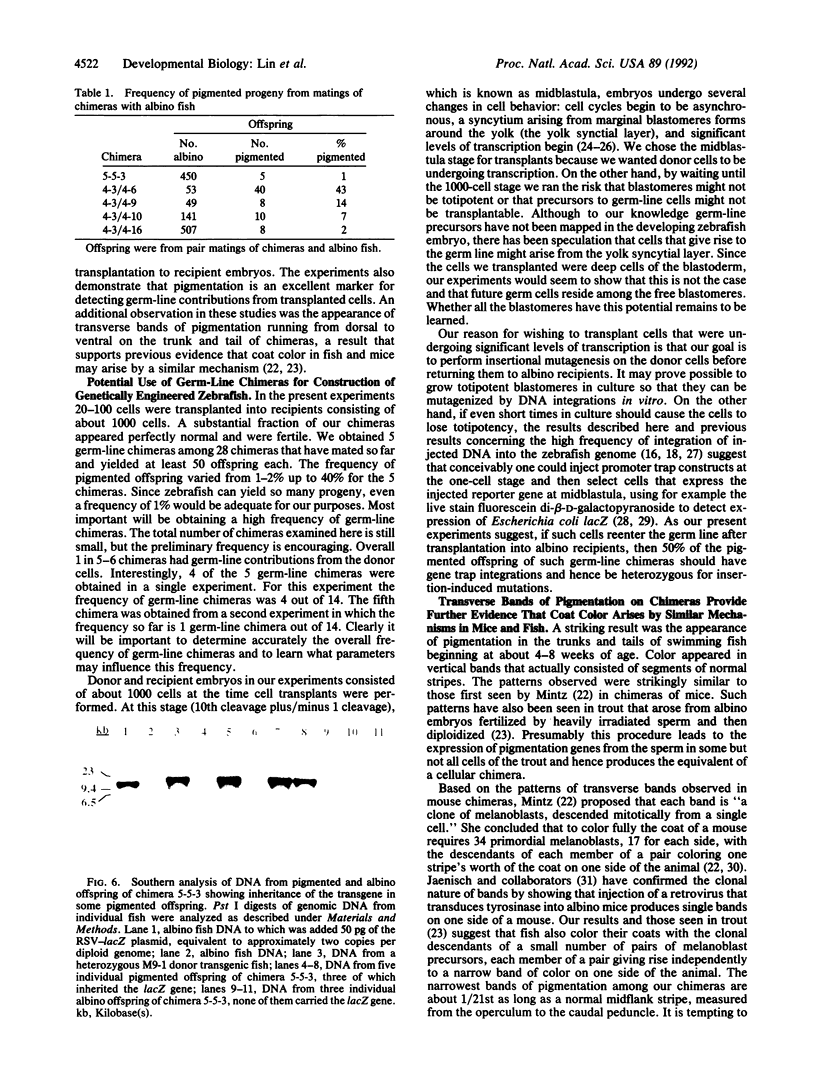
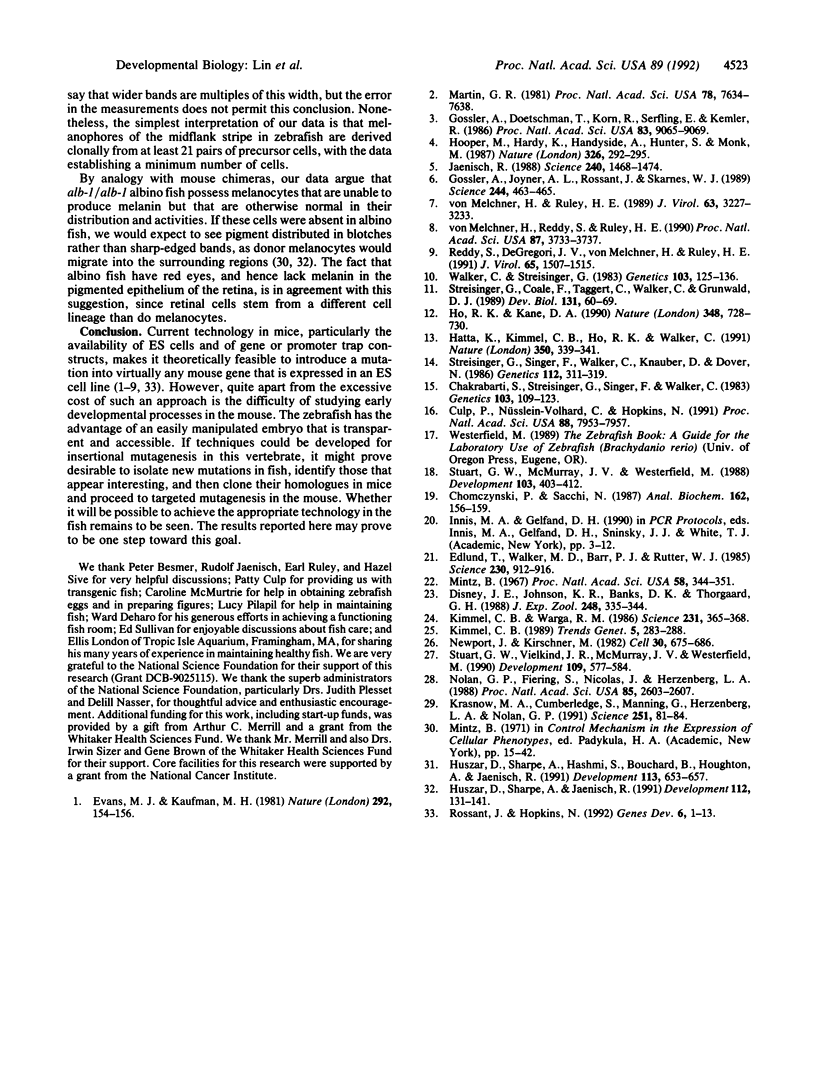
Images in this article
Selected References
These references are in PubMed. This may not be the complete list of references from this article.
- Chakrabarti S., Streisinger G., Singer F., Walker C. Frequency of gamma-Ray Induced Specific Locus and Recessive Lethal Mutations in Mature Germ Cells of the Zebrafish, BRACHYDANIO RERIO. Genetics. 1983 Jan;103(1):109–123. doi: 10.1093/genetics/103.1.109. [DOI] [PMC free article] [PubMed] [Google Scholar]
- Chomczynski P., Sacchi N. Single-step method of RNA isolation by acid guanidinium thiocyanate-phenol-chloroform extraction. Anal Biochem. 1987 Apr;162(1):156–159. doi: 10.1006/abio.1987.9999. [DOI] [PubMed] [Google Scholar]
- Culp P., Nüsslein-Volhard C., Hopkins N. High-frequency germ-line transmission of plasmid DNA sequences injected into fertilized zebrafish eggs. Proc Natl Acad Sci U S A. 1991 Sep 15;88(18):7953–7957. doi: 10.1073/pnas.88.18.7953. [DOI] [PMC free article] [PubMed] [Google Scholar]
- Disney J. E., Johnson K. R., Banks D. K., Thorgaard G. H. Maintenance of foreign gene expression and independent chromosome fragments in adult transgenic rainbow trout and their offspring. J Exp Zool. 1988 Dec;248(3):335–344. doi: 10.1002/jez.1402480312. [DOI] [PubMed] [Google Scholar]
- Edlund T., Walker M. D., Barr P. J., Rutter W. J. Cell-specific expression of the rat insulin gene: evidence for role of two distinct 5' flanking elements. Science. 1985 Nov 22;230(4728):912–916. doi: 10.1126/science.3904002. [DOI] [PubMed] [Google Scholar]
- Evans M. J., Kaufman M. H. Establishment in culture of pluripotential cells from mouse embryos. Nature. 1981 Jul 9;292(5819):154–156. doi: 10.1038/292154a0. [DOI] [PubMed] [Google Scholar]
- Gossler A., Doetschman T., Korn R., Serfling E., Kemler R. Transgenesis by means of blastocyst-derived embryonic stem cell lines. Proc Natl Acad Sci U S A. 1986 Dec;83(23):9065–9069. doi: 10.1073/pnas.83.23.9065. [DOI] [PMC free article] [PubMed] [Google Scholar]
- Gossler A., Joyner A. L., Rossant J., Skarnes W. C. Mouse embryonic stem cells and reporter constructs to detect developmentally regulated genes. Science. 1989 Apr 28;244(4903):463–465. doi: 10.1126/science.2497519. [DOI] [PubMed] [Google Scholar]
- Hatta K., Kimmel C. B., Ho R. K., Walker C. The cyclops mutation blocks specification of the floor plate of the zebrafish central nervous system. Nature. 1991 Mar 28;350(6316):339–341. doi: 10.1038/350339a0. [DOI] [PubMed] [Google Scholar]
- Ho R. K., Kane D. A. Cell-autonomous action of zebrafish spt-1 mutation in specific mesodermal precursors. Nature. 1990 Dec 20;348(6303):728–730. doi: 10.1038/348728a0. [DOI] [PubMed] [Google Scholar]
- Hooper M., Hardy K., Handyside A., Hunter S., Monk M. HPRT-deficient (Lesch-Nyhan) mouse embryos derived from germline colonization by cultured cells. Nature. 1987 Mar 19;326(6110):292–295. doi: 10.1038/326292a0. [DOI] [PubMed] [Google Scholar]
- Huszar D., Sharpe A., Hashmi S., Bouchard B., Houghton A., Jaenisch R. Generation of pigmented stripes in albino mice by retroviral marking of neural crest melanoblasts. Development. 1991 Oct;113(2):653–660. doi: 10.1242/dev.113.2.653. [DOI] [PubMed] [Google Scholar]
- Huszar D., Sharpe A., Jaenisch R. Migration and proliferation of cultured neural crest cells in W mutant neural crest chimeras. Development. 1991 May;112(1):131–141. doi: 10.1242/dev.112.1.131. [DOI] [PubMed] [Google Scholar]
- Jaenisch R. Transgenic animals. Science. 1988 Jun 10;240(4858):1468–1474. doi: 10.1126/science.3287623. [DOI] [PubMed] [Google Scholar]
- Kimmel C. B. Genetics and early development of zebrafish. Trends Genet. 1989 Aug;5(8):283–288. doi: 10.1016/0168-9525(89)90103-0. [DOI] [PubMed] [Google Scholar]
- Kimmel C. B., Warga R. M. Tissue-specific cell lineages originate in the gastrula of the zebrafish. Science. 1986 Jan 24;231(4736):365–368. doi: 10.1126/science.231.4736.365. [DOI] [PubMed] [Google Scholar]
- Krasnow M. A., Cumberledge S., Manning G., Herzenberg L. A., Nolan G. P. Whole animal cell sorting of Drosophila embryos. Science. 1991 Jan 4;251(4989):81–85. doi: 10.1126/science.1898782. [DOI] [PubMed] [Google Scholar]
- Martin G. R. Isolation of a pluripotent cell line from early mouse embryos cultured in medium conditioned by teratocarcinoma stem cells. Proc Natl Acad Sci U S A. 1981 Dec;78(12):7634–7638. doi: 10.1073/pnas.78.12.7634. [DOI] [PMC free article] [PubMed] [Google Scholar]
- Mintz B. Gene control of mammalian pigmentary differentiation. I. Clonal origin of melanocytes. Proc Natl Acad Sci U S A. 1967 Jul;58(1):344–351. doi: 10.1073/pnas.58.1.344. [DOI] [PMC free article] [PubMed] [Google Scholar]
- Newport J., Kirschner M. A major developmental transition in early Xenopus embryos: I. characterization and timing of cellular changes at the midblastula stage. Cell. 1982 Oct;30(3):675–686. doi: 10.1016/0092-8674(82)90272-0. [DOI] [PubMed] [Google Scholar]
- Nolan G. P., Fiering S., Nicolas J. F., Herzenberg L. A. Fluorescence-activated cell analysis and sorting of viable mammalian cells based on beta-D-galactosidase activity after transduction of Escherichia coli lacZ. Proc Natl Acad Sci U S A. 1988 Apr;85(8):2603–2607. doi: 10.1073/pnas.85.8.2603. [DOI] [PMC free article] [PubMed] [Google Scholar]
- Reddy S., DeGregori J. V., von Melchner H., Ruley H. E. Retrovirus promoter-trap vector to induce lacZ gene fusions in mammalian cells. J Virol. 1991 Mar;65(3):1507–1515. doi: 10.1128/jvi.65.3.1507-1515.1991. [DOI] [PMC free article] [PubMed] [Google Scholar]
- Rossant J., Hopkins N. Of fin and fur: mutational analysis of vertebrate embryonic development. Genes Dev. 1992 Jan;6(1):1–13. doi: 10.1101/gad.6.1.1. [DOI] [PubMed] [Google Scholar]
- Streisinger G., Coale F., Taggart C., Walker C., Grunwald D. J. Clonal origins of cells in the pigmented retina of the zebrafish eye. Dev Biol. 1989 Jan;131(1):60–69. doi: 10.1016/s0012-1606(89)80038-7. [DOI] [PubMed] [Google Scholar]
- Streisinger G., Singer F., Walker C., Knauber D., Dower N. Segregation analyses and gene-centromere distances in zebrafish. Genetics. 1986 Feb;112(2):311–319. doi: 10.1093/genetics/112.2.311. [DOI] [PMC free article] [PubMed] [Google Scholar]
- Stuart G. W., McMurray J. V., Westerfield M. Replication, integration and stable germ-line transmission of foreign sequences injected into early zebrafish embryos. Development. 1988 Jun;103(2):403–412. doi: 10.1242/dev.103.2.403. [DOI] [PubMed] [Google Scholar]
- Stuart G. W., Vielkind J. R., McMurray J. V., Westerfield M. Stable lines of transgenic zebrafish exhibit reproducible patterns of transgene expression. Development. 1990 Jul;109(3):577–584. doi: 10.1242/dev.109.3.577. [DOI] [PubMed] [Google Scholar]
- Walker C., Streisinger G. Induction of Mutations by gamma-Rays in Pregonial Germ Cells of Zebrafish Embryos. Genetics. 1983 Jan;103(1):125–136. doi: 10.1093/genetics/103.1.125. [DOI] [PMC free article] [PubMed] [Google Scholar]
- von Melchner H., Reddy S., Ruley H. E. Isolation of cellular promoters by using a retrovirus promoter trap. Proc Natl Acad Sci U S A. 1990 May;87(10):3733–3737. doi: 10.1073/pnas.87.10.3733. [DOI] [PMC free article] [PubMed] [Google Scholar]
- von Melchner H., Ruley H. E. Identification of cellular promoters by using a retrovirus promoter trap. J Virol. 1989 Aug;63(8):3227–3233. doi: 10.1128/jvi.63.8.3227-3233.1989. [DOI] [PMC free article] [PubMed] [Google Scholar]






